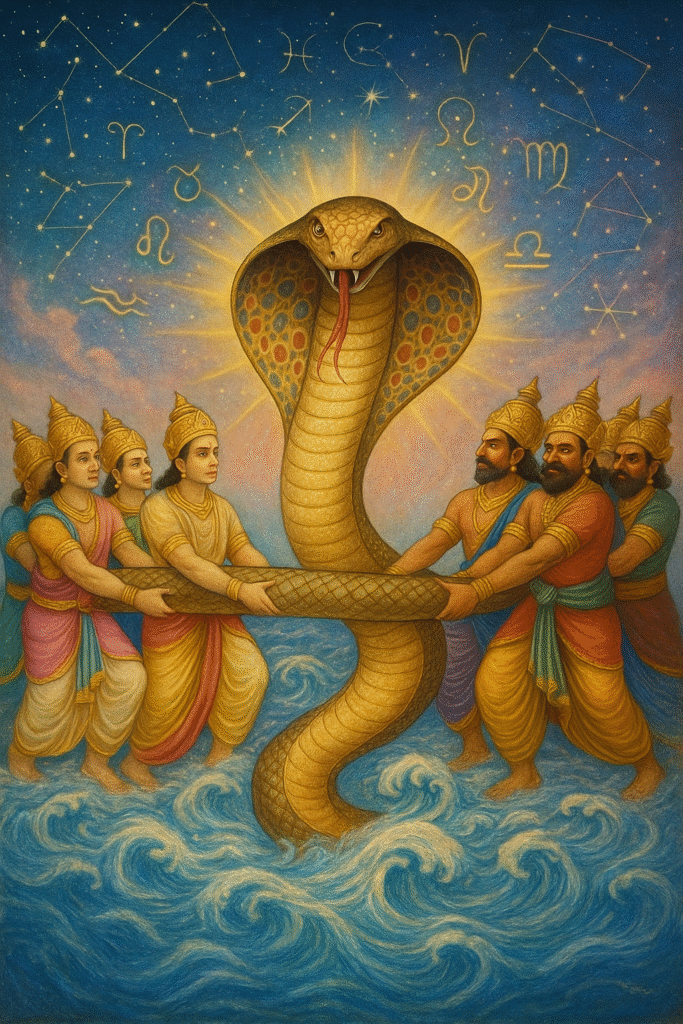
In the rich tapestry of Indian mythology, few beings hold as much mystique and spiritual significance as Vasuki, the king of serpents. Revered across Shaivite traditions and Vedic texts, Vasuki is not merely a mythical snake — he is a symbol of cosmic balance, spiritual power, and divine service.
Vasuki belongs to the Naga race — a class of semi-divine serpent beings mentioned in ancient scriptures. In Vedic and Puranic literature, Nagas are often misunderstood. Far from being symbols of evil, they are guardians of sacred knowledge, protectors of treasures, and custodians of the earth’s deeper mysteries. They reside in the subterranean realm called Patala, yet their influence extends to the celestial and earthly planes.
Nagendra Vasuki is among the most powerful of the Nagas, often described as having a thousand heads and a fiery aura. But beyond his form, it’s his actions and allegiances that define his spiritual depth.
Vasuki’s greatest honor is his eternal connection to Lord Shiva. In countless depictions, Vasuki is shown coiled gracefully around Shiva’s neck — calm, poised, and powerful. This is not merely artistic symbolism. In spiritual terms, Vasuki represents the awakened kundalini energy, which rises from the base of the spine to the crown chakra, resting in complete surrender at the feet of the Supreme.
Vasuki’s presence on Shiva’s body illustrates the perfect harmony between raw power and divine consciousness. The serpent, often feared and misunderstood, becomes a sacred ornament when aligned with truth and purpose.
Perhaps Vasuki’s most celebrated role is in the epic Samudra Manthan — the churning of the cosmic ocean. In this legend, the gods (Devas) and demons (Asuras) join forces to churn the Ocean of Milk to obtain Amrit, the nectar of immortality.
But such a task required a massive churning rope — and it was Vasuki who volunteered to serve this divine mission. He allowed himself to be wrapped around Mount Mandara, which was used as the churning rod. The Devas held one end of Vasuki, while the Asuras held the other, and they began to churn the ocean with him.
During the churning, Vasuki endured great suffering — his body emitted poisonous fumes, and his pain shook the heavens. Yet, he did not withdraw. His sacrifice led to the emergence of divine gifts from the ocean, including Lakshmi (the goddess of wealth) and finally, Amrit, the nectar of immortality.
This act represents selfless service, spiritual endurance, and the transformational journey of the soul through trials and purification.
In yogic philosophy, Vasuki symbolizes the coiled serpent energy — kundalini shakti — which lies dormant in every human being. Just as Vasuki uncoils to serve the divine will, our own energy awakens when aligned with higher consciousness.
Vasuki also teaches us about duality and unity. He served both Devas and Asuras, yet his intention was pure — to assist in the cosmic evolution. Similarly, the soul’s path may pass through both light and shadow, but its goal remains unity with the Divine.
In today’s spiritual world, Vasuki is more than myth — he is a reminder of strength in surrender, wisdom in silence, and purpose in service. Whether you are a seeker on the path of astrology, yoga, tantra, or devotion, the symbol of Vasuki offers timeless inspiration.
At Vasuki Vedic Astrology, we honor this sacred symbol as a guide — embodying deep intuition, transformative energy, and unwavering devotion to truth.
